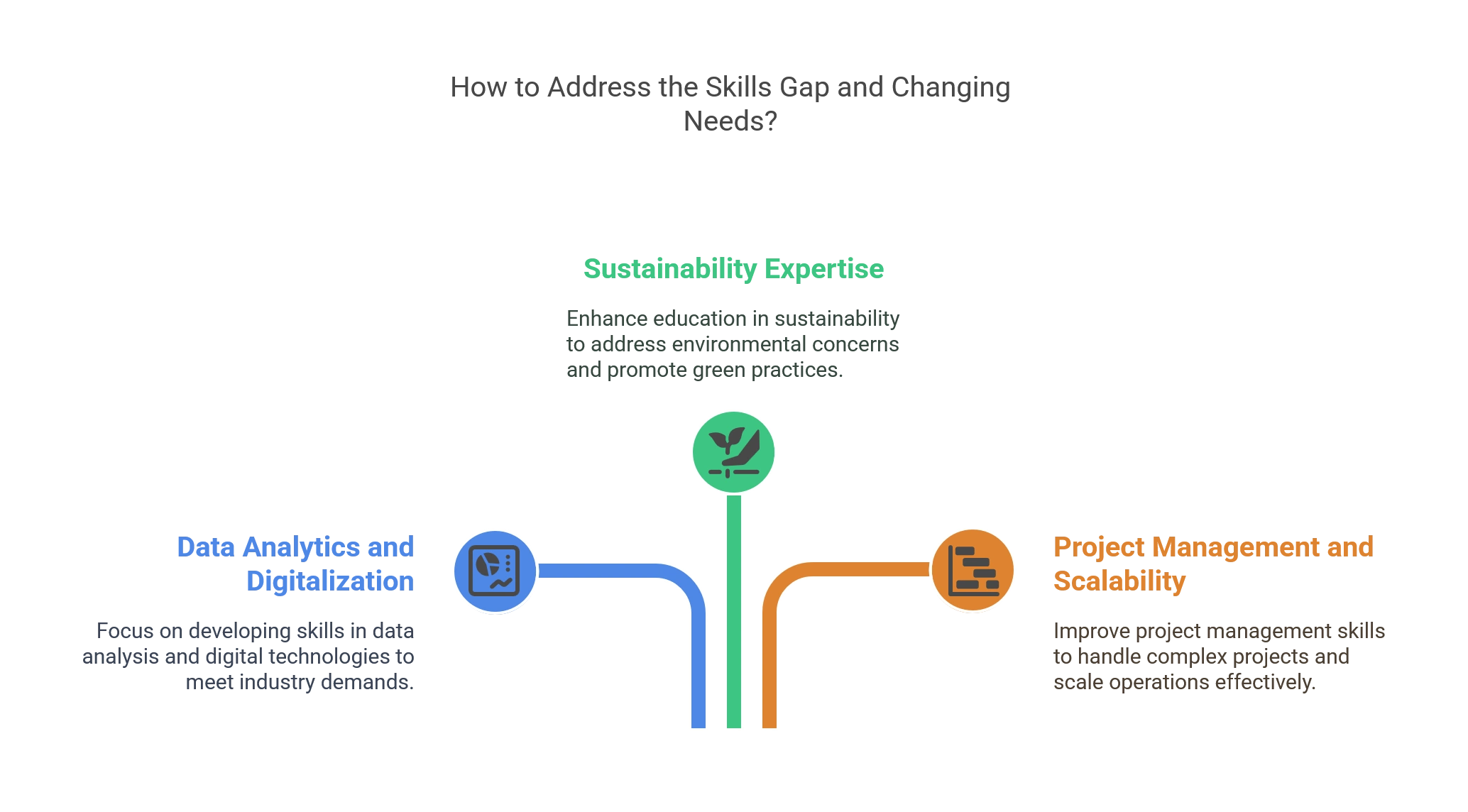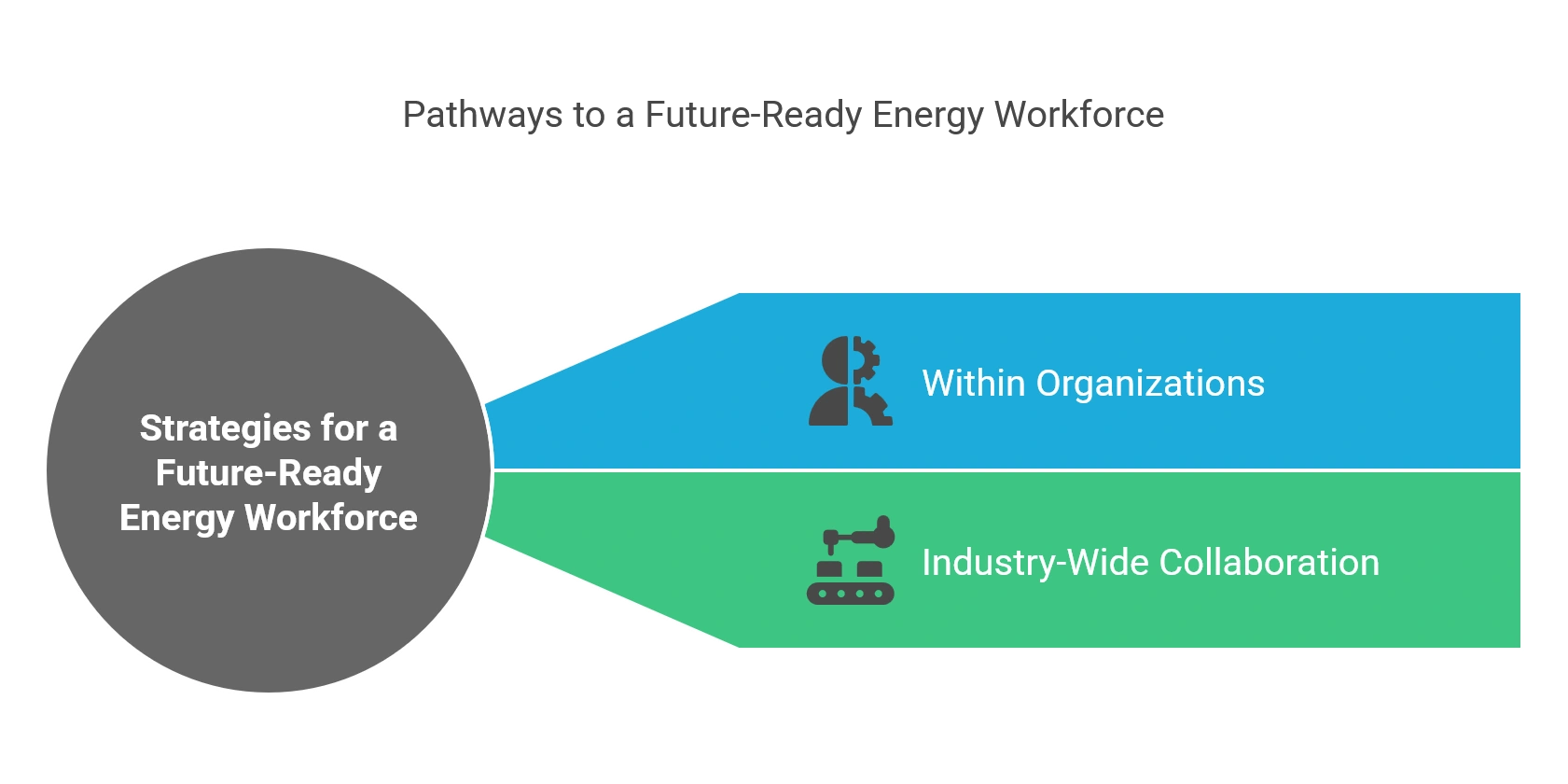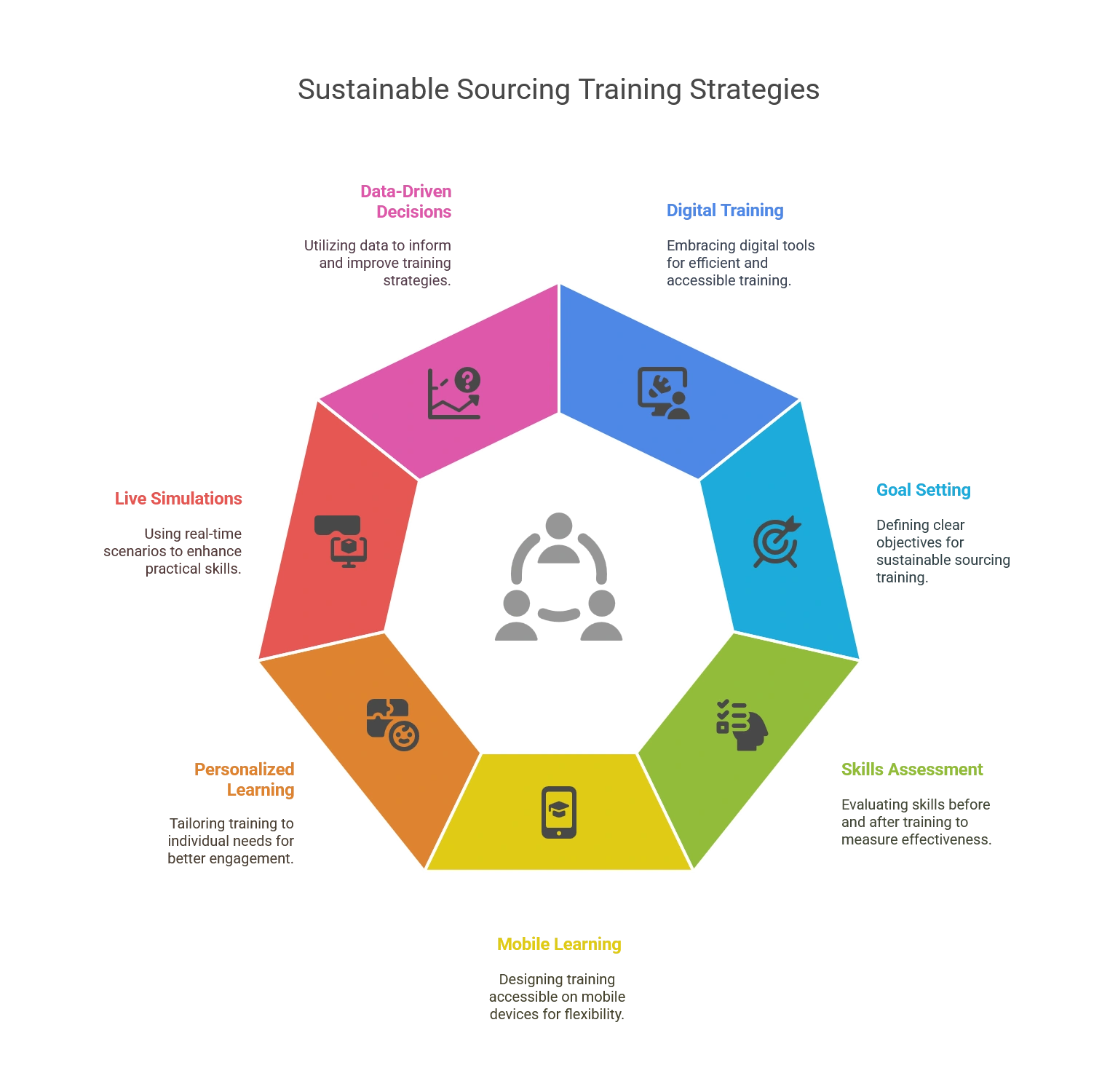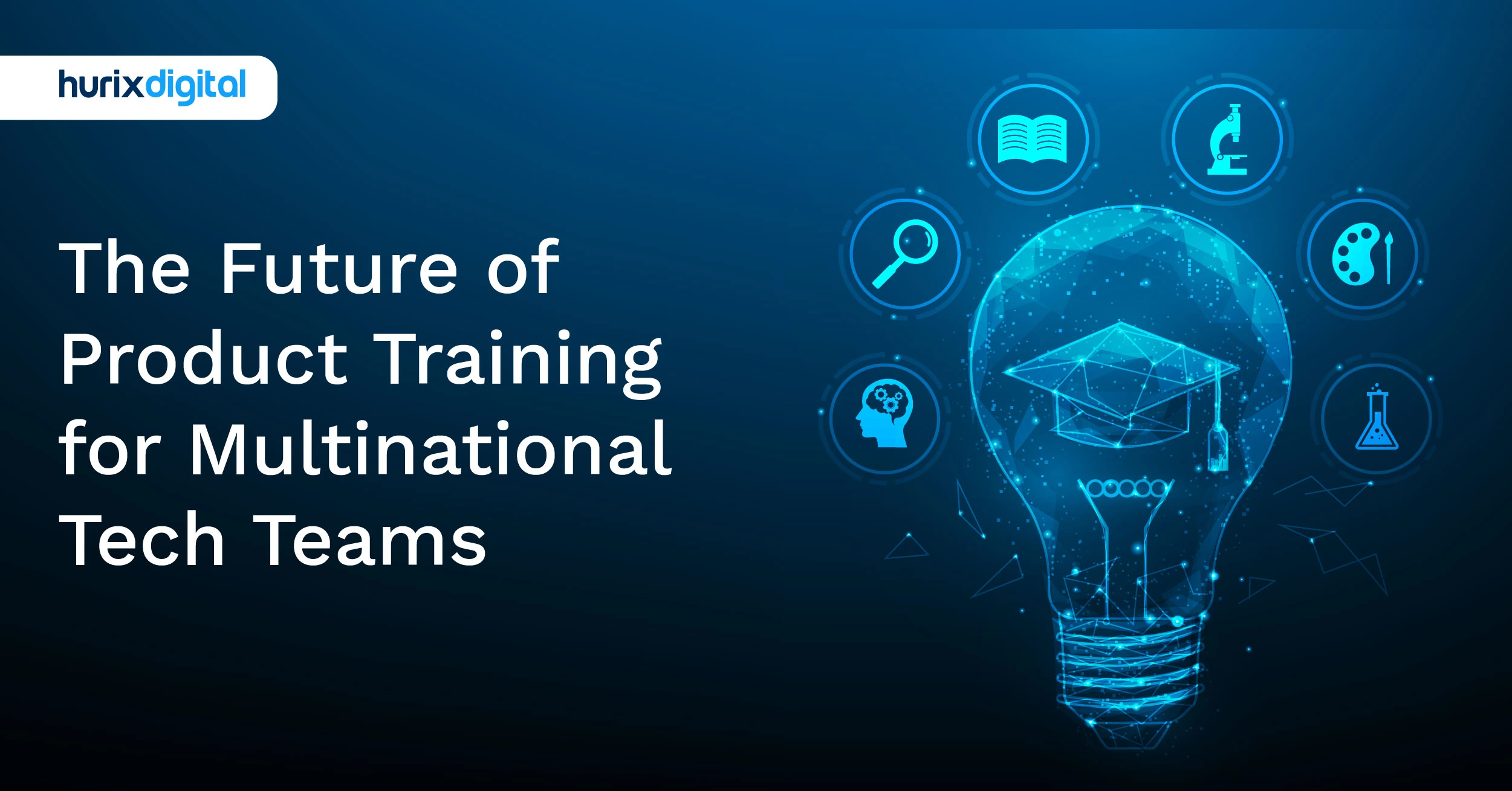
How Can the Oil & Gas Workforce Adapt to a Changing Energy Landscape?
Summarize with:
The global energy landscape is undergoing a seismic shift.
Driven by concerns about sustainability, countries and businesses are adopting renewable energy sources at an increasing rate. Projections estimate that these sources will account for half of the global energy mix by 2050.
This rearrangement presents a critical challenge for the oil & gas industry, demanding a skilled and adaptable workforce primed to succeed in this evolving environment.
Workforce transformation is indispensable for oil and gas companies, given the demands of the rapidly changing energy industry and the need to close the emerging skills gap.
Read on as we explore how companies implement comprehensive reskilling and upskilling programs to equip their workforce with expertise in renewable energy technologies and sustainable practices.
Table of Contents:
- Understanding the Energy Transition
- What is Sustainable Procurement Workforce Training?
- The Challenge: Skills Gap and Changing Needs
- Strategies for a Future-Ready Energy Workforce
- Importance of Sustainable Sourcing Strategies in the Oil and Gas Sector
- 7 Key Sustainable Sourcing Workforce Training Strategies
- Conclusion
Understanding the Energy Transition
The transition to cleaner energy presents a compelling opportunity for job creation. In a major report, the International Energy Agency (IEA) predicts over 30 million fresh jobs in the green energy sector by 2030.
The employment market for fossil fuels will contract in tandem with this increase, especially in sectors like coal supply, which are experiencing significant downsizing due to decarbonization and automation. Proactive workforce transformation is necessary to capitalize on the opportunities a low-carbon energy future has created.
This workforce transformation process is already underway for businesses and employees looking to acquire a competitive edge. Fortunately, most current energy experts are well-positioned to move to cleaner energy sources.
The good news is that most energy experts who are now employed are qualified to switch to cleaner energy sources.
According to a recent Robert Gordon University study, more than 90% of UK workers in the oil and gas industry have transferable skills highly applicable to positions in renewable energy. These transferable abilities, including project management, engineering, and health and safety procedures knowledge, and experience servicing and maintaining complicated systems, are all valuable assets in the renewable energy industry.
What is Sustainable Procurement Workforce Training?
The sustainable procurement workforce training program is a structured approach toward skilling employees in the most cost-effective and environmentally friendly supply chain management practices.
In the context of oil and gas companies, the training must empower teams to apply sustainable processes in procuring raw materials. These practices can ensure limited environmental damage. Simultaneously, cost and Return On Investment (ROI) are important in ensuring that companies function optimally and become profitable.
Embracing digital training can help businesses execute training quickly, effectively, and at scale.

The Challenge: Skills Gap and Changing Needs
The energy transition requires a comprehensive reevaluation of the skill sets needed in the Oil and Gas industry, alongside enhanced workforce training programs. While traditional expertise in exploration and drilling remains valuable, it is no longer sufficient to meet the evolving demands of the sector.
A new and multifaceted skills gap is emerging as the industry embraces cleaner energy sources.
To bridge this gap and ensure long-term success, oil & gas companies must prioritize the development of critical capabilities in several key areas:
1. Data Analytics and Digitalization
For example, wind, solar, and geothermal power significantly rely on data analysis to maximize efficiency and forecast energy production.
Conventional oil and gas workers might not be as adept at managing and interpreting data as they should be, which would limit their capacity to make meaningful contributions to the new energy environment.
In addition, the sector is rapidly changing due to digitalization. Integrating renewable energy sources into the system requires a thorough understanding of digital communication protocols and smart grid technology.
2. Sustainability Expertise
Sustainability initiatives are becoming increasingly significant in the energy sector.
Moreover, understanding carbon capture and storage technology and ways to reduce environmental effects is essential for conscientious growth in the renewable energy sector.
3. Project Management and Scalability
The workforce is essential to enabling scalability, a key factor in the success of the energy sector. Workforce training programs play a pivotal role in equipping employees with the skills needed to drive growth and adaptability.
Energy firms require a staff capable of handling ever-more complicated operations as they grow both regionally and throughout various areas of the energy value chain.
Workers with a variety of skill sets, from data analytics to project management, are needed to guarantee the smooth integration of new assets, efficient processes, and the upholding of quality and safety standards on a large scale.

Strategies for a Future-Ready Energy Workforce
Upskilling current employees and attracting new talent with expertise in renewable energy are vital elements of the oil and gas industry’s workforce transformation strategy.
When supported by targeted workforce training programs and applied at corporate and sectoral levels, these efforts can help the energy sector build a more inclusive, diverse, and adaptable workforce.
1. Within Organizations
Here’s a snapshot of how organizations can strategically prepare their workforce for the future:
- Future-Back Workforce Planning: Companies must proactively use strategic workforce planning. It involves carefully analyzing workplace transformation strategy, market demand, and current attrition trends to pinpoint the skills and talent required for the future. Businesses can utilize this data to prioritize efforts in upskilling and guarantee that they are developing a workforce capable of tackling upcoming challenges.
- Leadership for Change: Executive leadership must be firmly on board to cultivate a diverse and inclusive workforce. It necessitates a unified commitment to quantifiable DEI goals, a clear understanding of the need for change, and the establishment of measurable targets. To provide a clear grasp of the business case for change and to build an inclusive culture, effective leadership necessitates a blend of empathy and rationality.
- Upskilling and Capability Building: Successfully bridging the skills gap requires strategic investment in workforce training programs and continuous learning. Human resources, cultural leaders, and managers need enhanced capabilities to identify skill gaps, promote inclusive behaviors, align organizational systems, and foster empathetic leadership.
- Building the Infrastructure for Progress: Tracking progress and encouraging accountability are crucial. Organizations should establish dedicated DEI teams and committees, implement data collection and measurement systems, and tie executive incentives to DEI goals.
2. Industry-Wide Collaboration
Here’s a glimpse of how industry-wide collaboration can further enhance the readiness of the energy workforce for the future:
- Cross-Industry Collaboration on DEI: The Workforce Energy project of the International Association of Oil & Gas Producers is a paradigm for industry-wide cooperation on DEI initiatives. Businesses that join this effort can pool their resources and expertise, exchange best practices, and work together to solve the skills shortage.
- The DEI Metrics are Standardized: Companies can benchmark their progress and pinpoint areas for improvement by establishing clear, standardized DEI criteria with minimum commitments and transparency expectations. This common framework encourages responsibility and promotes advancement within the sector.
- Sharing Best Practices: Openly sharing best practices for attracting and retaining a diverse workforce benefits the entire industry. Treating this as a collaborative effort with shared opportunities allows companies to learn from each other’s successes and accelerate progress.
- Monitoring Infrastructure for Public Accountability: Establishing a monitoring infrastructure is essential for maintaining public trust and holding businesses accountable for their DEI promises.
- Sustainability Focus: The sector’s potential to thrive in the future depends on its dedication to sustainable solutions. Prospective employees who value working for organizations with a positive impact will be impressed by a focus on environmental responsibility.
- Workforce as the Core: The industry’s success revolves around its workforce, which is considered its core. Prioritizing human-centric methods that encourage a healthy work environment and promote employee well-being is necessary to retain qualified staff.
Importance of Sustainable Sourcing Strategies in the Oil and Gas Sector
Though the demand for renewable energy is rising, the global energy mix in 2025 is estimated to comprise 48% of fossil fuels. However, oil and gas companies must strive to reduce their carbon footprint. One approach is to adopt sustainable procurement best practices that comply with Environmental, Social, and Governance (ESG) frameworks.
Complying with ESG frameworks is an important goal of forward-thinking oil and gas companies. By doing so, businesses can attract more investors, forge critical partnerships, and access rewards such as sustainability tax credits. They will be able to mitigate financial and business sustainability risks.
Hence, investments in cost-effective sustainability training are emerging as the need of the hour. By delivering timely training, businesses can innovate and reap the benefits of being ESG-compliant.

7 Key Sustainable Sourcing Workforce Training Strategies
Below’s a snapshot of how oil and gas companies can make their workforce training strategies robust, high-impact, and cost-effective.
1. Adopt a Digital Training Methodology
Sustainability guidelines will continue to evolve based on ESG needs and goals. Hence, training content and delivery must be consistent and dynamic.
Adopting a digital training approach is a primary way to achieve these goals. Early investments in AI-powered, cloud-based Learning Management Systems (LMS) can enable businesses to develop and distribute training materials efficiently. They can also scale training, boost collaboration, and encourage self-learning.
2. Identify Key Sustainable Sourcing Training Goals
Businesses must identify key learning outcomes that effectively equip employees through targeted workforce training programs to adopt sustainable procurement practices. Once these outcomes are defined, the curriculum design within these programs should be aligned and optimized to support and achieve these sustainability goals.
Business teams must execute training materials and methodology to meet sustainability goals, considering learning barriers, accessibility needs, and geographical concerns.
3. Assess Pre- and Post-training Skills Levels
To help optimize training impact, business teams must thoroughly assess existing skill levels. Knowing where the workforce training program stands regarding knowledge and skills can help businesses deliver the right level of training, identify training outcomes, and define key measurability parameters.
Once the training is completed, participants must be tested on their skill levels to measure training success. Their performance on supply chain sustainability must be monitored and analyzed to determine further training needs.
4. Design a Mobile-First Learning Experience
Today’s learners are shifting towards mobile learning due to its convenience and flexibility. Access to mobile data and a basic smartphone enable a smooth learning experience. However, the learning experience must be optimized for a mobile-first experience, which includes optimization for low or no connectivity.
For instance, participants can easily access multimedia resources, attend live video conferences, and download eBooks and other multimedia resources. Mobile-based learning can nudge participants to engage in self-learning, practice more, and log in from anywhere, anytime, based on classroom schedules.
5. Personalize the Learning Experience
As job roles become more specialized, the tide shifts towards a highly personalized user experience. Hence, oil and gas companies must be able to personalize the learning experience for maximum impact.
Shifting from a legacy LMS to an AI-powered LMS can automate the personalization process. Companies can generate lessons and assessments according to a participant’s unique learning needs and challenges.
6. Enable Building Skills via Live Simulations
While understanding theory and fundamentals is essential, workforce training programs must also focus on enabling employees to apply their knowledge in real-life situations. A key challenge for businesses is preparing teams to respond effectively across various scenarios. Emerging technologies like virtual reality (VR) and augmented reality (AR) are transforming workforce training programs, making them more immersive and impactful in meeting this need.
Businesses can now simulate multiple scenarios and enable employees to practice with diverse parameters. Benefits include a lack of financial and physical risks and unlimited practice within all permutations and combinations.
7. Leverage Data to Make Key Training Decisions
The measurability of energy sector sustainability training is an important aspect of the entire training framework. A superior automated LMS comes with robust AI-based data analytics.
Businesses can track all aspects of participant engagement, analyze trends, and make data-driven decisions. They can also predict participants’ performance based on historical data. Training can be tweaked to suit individual strengths and needs.
Conclusion
The efficient adoption and execution of sustainability sources’ best practices are key to helping oil and gas companies survive and thrive in an environmentally focused world.
Timely, dynamic digital workforce training programs can help businesses maintain ESG standards and benefit in multiple ways. These include sustainability credits, investment offers, compliance recognition, and environmental impact.
Oil and gas businesses aiming to adhere to ESG global standards must consider implementing a robust and scalable digital training model. Hurix Digital is geared toward helping companies transform their training methods and drive results with customized solutions.
Get in touch with us to start a conversation.
Summarize with:

Senior Vice President
Julia brings over 20 years of global experience in digital learning and business strategy. She specializes in client success, enterprise learning solutions, and driving growth through innovation, with a focus on AI, VR, and emerging technologies across diverse industry verticals.
 A Space for Thoughtful
A Space for Thoughtful 



